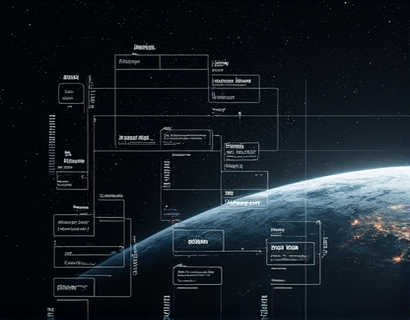Maximize Leadership Efficiency: A Comprehensive Dashboard for Streamlined Team Management and Enhanced Productivity Across Diverse Industries
In today's fast-paced business environment, effective leadership is more crucial than ever. Leaders are tasked with managing diverse teams, making strategic decisions, and driving productivity across various industries. To achieve these goals, a comprehensive management dashboard can be an invaluable tool. This article explores how such a dashboard can maximize leadership efficiency, streamline team management, and enhance productivity.
The Importance of Leadership Efficiency
Leadership efficiency refers to the ability of leaders to manage their teams effectively while optimizing resources and time. In a world where businesses are constantly evolving, leaders must adapt to new challenges and opportunities. Efficient leadership not only improves team performance but also fosters a positive work environment, encourages innovation, and drives organizational success.
Understanding the Role of a Management Dashboard
A management dashboard is a visual representation of key performance indicators (KPIs) and metrics that provide leaders with real-time insights into their team's performance. It consolidates data from various sources, allowing leaders to monitor progress, identify trends, and make informed decisions. By utilizing a management dashboard, leaders can streamline operations, enhance communication, and empower their teams.
Key Features of an Effective Management Dashboard
To maximize leadership efficiency, a management dashboard should include several key features:
- Real-Time Data Tracking: The ability to track performance metrics in real-time allows leaders to make timely decisions and address issues as they arise.
- Customizable Views: Different teams may require different data sets. A customizable dashboard enables leaders to tailor the information displayed to meet the specific needs of their teams.
- Collaboration Tools: Integrated communication tools facilitate collaboration among team members, ensuring that everyone is on the same page and working towards common goals.
- Data Visualization: Visual representations of data, such as graphs and charts, make it easier for leaders to interpret complex information and identify trends.
- Goal Setting and Tracking: The ability to set, track, and measure progress towards goals helps teams stay focused and motivated.
Streamlining Team Management
One of the primary benefits of a management dashboard is its ability to streamline team management. By providing leaders with a centralized platform to oversee their teams, the dashboard simplifies various management tasks.
Enhanced Communication
Effective communication is essential for successful team management. A management dashboard can enhance communication by providing a platform for team members to share updates, ask questions, and collaborate on projects. This transparency fosters a culture of open communication, which is vital for team cohesion and productivity.
Improved Decision-Making
Leaders often face complex decisions that require careful consideration of various factors. A management dashboard provides leaders with the data they need to make informed decisions quickly. By analyzing real-time data, leaders can identify trends, assess risks, and evaluate potential outcomes, leading to more effective decision-making.
Resource Allocation
Efficient resource allocation is critical for maximizing productivity. A management dashboard allows leaders to monitor resource usage and identify areas where resources may be underutilized or overextended. This insight enables leaders to allocate resources more effectively, ensuring that teams have the tools and support they need to succeed.
Enhancing Productivity Across Diverse Industries
Different industries have unique challenges and requirements, but a management dashboard can enhance productivity across the board. Here are some ways it can be applied in various sectors:
Healthcare
In the healthcare industry, a management dashboard can help leaders monitor patient care metrics, track staff performance, and manage resources effectively. By providing real-time insights into patient flow and staff workload, healthcare leaders can make informed decisions that improve patient outcomes and operational efficiency.
Manufacturing
Manufacturing leaders can benefit from a management dashboard by tracking production metrics, monitoring equipment performance, and managing supply chain logistics. By analyzing data on production efficiency and downtime, leaders can identify areas for improvement and implement strategies to enhance productivity.
Retail
In the retail sector, a management dashboard can help leaders monitor sales performance, track inventory levels, and analyze customer behavior. By leveraging data insights, retail leaders can make informed decisions about product offerings, marketing strategies, and staffing levels, ultimately driving sales and customer satisfaction.
Technology
In the technology industry, a management dashboard can assist leaders in tracking project progress, managing team workloads, and monitoring software development metrics. By providing real-time insights into project timelines and team performance, technology leaders can ensure that projects stay on track and meet deadlines.
Empowering Strategic Decision-Making
Strategic decision-making is a critical aspect of effective leadership. A management dashboard empowers leaders to make strategic decisions by providing them with the data and insights they need to evaluate options and assess potential outcomes.
Data-Driven Insights
Data-driven decision-making is essential for organizational success. A management dashboard consolidates data from various sources, allowing leaders to analyze trends and patterns. By leveraging these insights, leaders can make informed decisions that align with their organization's goals and objectives.
Scenario Planning
Effective leaders often engage in scenario planning to anticipate potential challenges and opportunities. A management dashboard can facilitate this process by allowing leaders to model different scenarios based on various data inputs. This capability enables leaders to evaluate potential outcomes and develop contingency plans, ensuring that their teams are prepared for any situation.
Implementing a Management Dashboard
Implementing a management dashboard requires careful planning and consideration. Here are some steps to ensure a successful implementation:
- Define Objectives: Clearly outline the objectives you want to achieve with the management dashboard. This will guide the selection of metrics and features.
- Involve Stakeholders: Engage team members and stakeholders in the implementation process. Their input can provide valuable insights into the features and metrics that will be most beneficial.
- Select the Right Tools: Choose a management dashboard tool that aligns with your organization's needs and objectives. Consider factors such as ease of use, customization options, and integration capabilities.
- Train Your Team: Provide training to team members on how to use the management dashboard effectively. This will ensure that everyone is equipped to leverage the tool to its full potential.
- Monitor and Adjust: Continuously monitor the effectiveness of the management dashboard and make adjustments as needed. Solicit feedback from team members to identify areas for improvement.
Measuring Success
To determine the effectiveness of a management dashboard, leaders should establish key performance indicators (KPIs) to measure success. These KPIs may include:
- Improvement in team productivity
- Reduction in project completion times
- Increased employee engagement and satisfaction
- Enhanced decision-making speed and accuracy
- Improved resource allocation efficiency
By regularly assessing these KPIs, leaders can evaluate the impact of the management dashboard on their team's performance and make data-driven decisions to optimize their management processes further.
Conclusion
Maximizing leadership efficiency is essential for driving productivity and success across diverse industries. A comprehensive management dashboard serves as a powerful tool for leaders, enabling them to streamline team management, enhance communication, and empower strategic decision-making. By implementing a management dashboard, leaders can optimize their management processes, improve team performance, and ultimately achieve their organizational goals. As the business landscape continues to evolve, embracing innovative tools and technologies will be key to staying ahead and fostering a culture of efficiency and productivity.










































